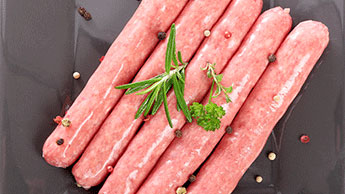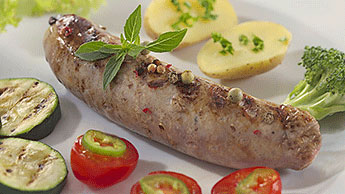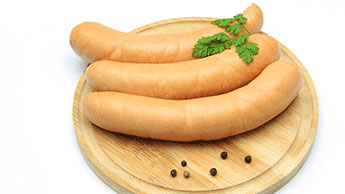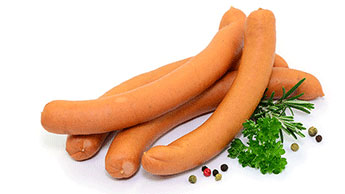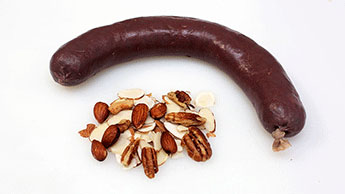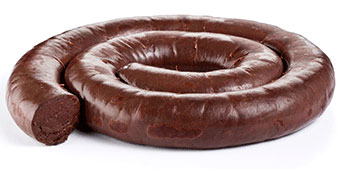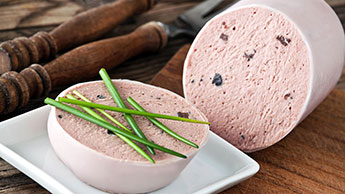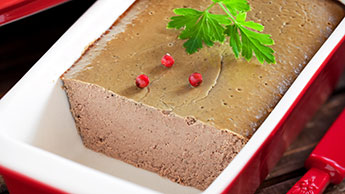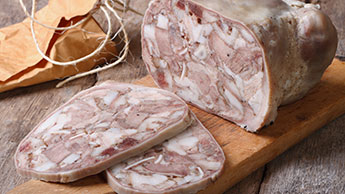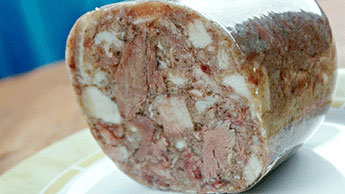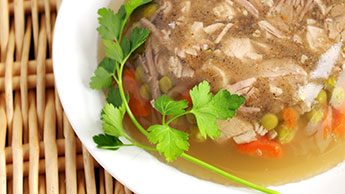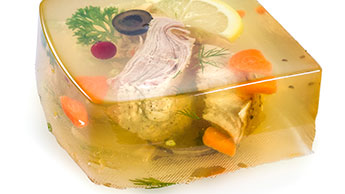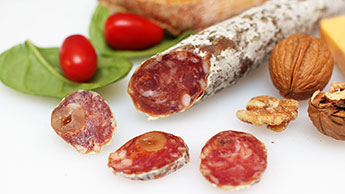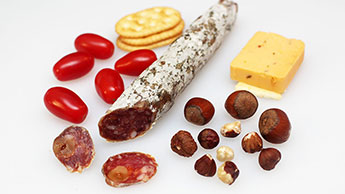Meats and Sausages
French Sausages
The technology for making sausages is basically the same in France as in other countries, but the texture, flavor, and aroma of French sausages are original and slightly different. This may be attributed to the fact that the past sausages were made with locally grown herbs and spices and those were influenced by climatic conditions. People in certain regions developed a liking for certain sausages, and in time those became known nationwide.
Although French is the prettiest language of them all, nevertheless, the names of French sausages may look confusing to many. In French both words “saucisson” and “saucisse” denote a sausage, however, each word is reserved for a sausage of a different physical size namely the diameter. The saucisson is a bigger sausage than the saucisse, for example Saucisson de Foie and Saucisse de Foie is the liver sausage made to the same recipe, but saucisson is thicker. The meat that goes into “saucisse” may be ground with a smaller plate. The sausage often gets its name from the filler material or peculiar ingredient when added in substantial quantity, for example Boudin Noir Aux Noix (Blood Sausage with Nuts) or Boudin Noir à la Crème (Blood sausage with Cream).
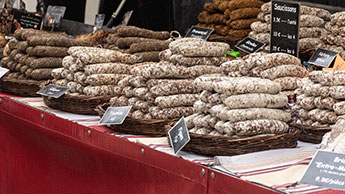
French sausages are made with aromatic spices and herbs. Oregano is less popular than in Spanish and Italian sausages. Smoking meats is popular but not to such an extent as in Germany, Poland, or Russia. The typical French ingredients that are incorporated into French cuisine are Quatre épices and Bouquet garni.
Quatre épices
Quatre épices - French for "4 spices" is a spice combination that can vary in strength and combination of spices; however, it always contains nutmeg, cinnamon, and cloves. The fourth ingredient can be ginger, allspice, or caraway or their combination. Occasionally, a touch of white pepper is also included. Note that sometimes the term four-spice may refer to allspice from Jamaica. This is because allspice when being ground, releases aromas of ginger, clove, nutmeg, and pepper.
A typical “quatre épices” combination for 1 kg (2.2 lb) of sausage mix that is used in blood sausages, pates and jellies:
Nutmeg 2.0 g
Cinnamon, 3.0 g
Cloves, 2.0 g
Caraway, 1.5 g
Allspice, 1.5 g
Bouquet garni
Bouquet garni - French for "garnished bouquet," is a classic herb mixture used for preparing stocks, soups, meats, and vegetables so it is not surprising that is added to sausages, too. The traditional combination is parsley, thyme, and bay leaf, but you may also find recipes that include other herbs such as rosemary, basil, chervil, peppercorn, and tarragon.
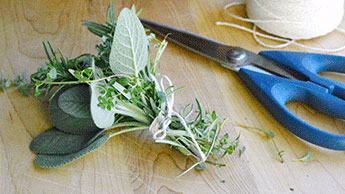
You can make bouquet garni with fresh or dried herbs. If the herbs are fresh, the combination is secured with a bit of cooking twine, while cheesecloth is generally used to wrap the dried herbs, and the bundle is secured with twine. Both, quatre épices and bouquet garni can be added at the same time. Often, instead of bouquet garni only white pepper and quatre épices are added.
Cream – or full milk is added not only to cooked sausages (boudin), but even to liver and blood sausages.
Eggs – adding eggs to sausages is a common practice in France and Germany. In fresh and cooked sausages, they bind ingredients together and they act as an emulsifier in liver sausages.
All types of sausages may be encountered in France: fresh, cooked, liver and blood sausages, head cheeses and dry sausages (salami type).
Fresh Sausages
These are not-ready-to-eat sausages. A fresh sausage is basically spiced ground meat filled into a casing. They must be fully cooked (water cooked, fried or grilled) before serving.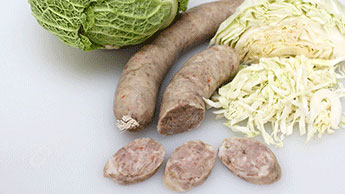
Saucisse de Choix (cabbage sausage). After being stuffed, fresh sausages may be fully cooked becoming ready-to-eat sausages .
Cooked Sausages
Cooked sausages are submitted to a thermal process. They are ready-to-eat at any time. Some sausages, usually the smoked ones, are served cold, the others taste better when they are boiled or fried.
Boudin Blanc
Boudin Blanc (blanc = white) is the King of French sausages. It is a light-colored sausage usually made with cream or full milk, also whole egg or egg white, the latter will produce a lighter texture. As the name implies, it is a white sausage, so lightly colored meats should be selected: pork loin, light-colored pork, hard pork fat (back fat), veal, chicken breast, white flesh fish such as whiting, pollock, cod, hake, halibut, sole. White pepper is a must, natural flavoring extracts are helpful, too. The sausage texture should be uniformly white without displaying chopped herbs and spices.
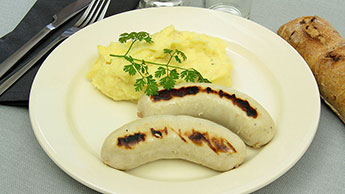
Boudin Blanc
There are two methods of applying milk:
- Hot milk method (à chaud) - herbs and spices are simmered in hot milk. The infusion is filtered, mixed with ground meat, and stuffed into casings. This method is time-consuming but it will produce lighter sausage than the easier and faster cold milk method.
- Cold milk method (à froid) - milk is applied cold along with spices and all ingredients.
Materials used for making boudin blanc, such as eggs and milk, spoil rapidly so the finished sausage must be refrigerated and consumed within days. It should be noted that in the state of Louisiana (USA), there are a number of French sausages that differ slightly from the originals, for example, Boudin Blanc which is made with rice but no milk.
Boudin Noir – (Blood Sausage)
English call sausages that contain filling material such as groats, rusk, bread, or rice “pudding. The ones that contain blood are known as “Black Pudding,” as blood acquires black color when cooked. The ones without blood are called “White Pudding” because they are of light color. They are basically light-colored cooked sausages. This naming system is used in other countries like Poland, Germany, Spain and France.
In France these sausages are known as Boudin.
- Boudin Noir (“noir”means “black”) – blood sausages
- Boudin Blanc (“blanc” means “white”) – cooked sausages (no blood)
Occasionally, cream or full milk is added d to blood sausages (Boudin Noir á la Créme). Like most blood sausages, Boudin Noir is a cooked sausage, boiled in water, so it is ready to eat at any time. However, it tastes best when grilled, baked, or fried. Remember that blood becomes black when fried so the served sausage will be dark.
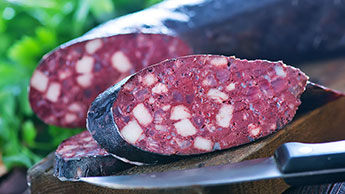
Boudin Noir de Lyon is a French blood sausage from Lyon made with blood, onions and diced fat that becomes a visible show-material.
Onions
Onion is one of the three major ingredients (blood, fat, onions) of any blood sausage, however, in many countries, onions are added in small quantities (3-10%). In French (and in Spanish) sausages, onions are usually added at 10-30%. The taste of the sausage can suffer if such a large amount of onions is not properly prepared. Raw onions taste sharp and bitter, hence, adding 25% of raw onions is not a good idea. Secondly, cutting or grinding such amount of onions can be an unpleasant experience resulting in tears and crying. For best results fry onions in some fat on medium fire until they become glassy or golden. They taste sweet when golden, but when over-fried to a brown color they become bitter.
Spices
Blood sausage likes aromatic spices so cinnamon, nutmeg and cloves are on top of the list.<.p>
Saucisson/Saucisse de Foie - (Liver Sausage)
Saucisson de Foie (“foie” = liver) is French liver sausage. French are masters of making great patés, which they make from a variety of meats and ingredients. The most famous is “foie gras” (gras = fat, foie = liver) which is made from goose or duck liver. Basically, there is not much difference between liver sausage and paté. Paté is a paste, pie, or loaf consisting of finely comminuted meat, fat, and liver. If paté is stuffed into a casing it would become a sausage. In order to be spreadable a good paté or liver sausage must contain a large amount of fat. A soft fat will contribute positively to spreadability. The purpose of the liver is twofold:
- It provides the characteristic taste and flavor.
- It encapsulates meat and fat particles with a thin coat of protein preventing them from sticking together. This allows the sausage to be easily spread on a roll or bread. It must be noted that only raw liver has emulsifying properties; a cooked liver will not encapsulate fat particles with a protein coat. However, if the liver is not perfectly clean, it can be scalded in hot water (below a boiling point) for 3-5 minutes.
The egg is often added to liver sausages as it also has strong emulsifying properties, after all , we make mayonnaise by whisking egg yolk with a large amount of vegetable oil.
A fresh cream is occasionally added to French liver sausages at about 3% (Saucisson de Foie a la Crème Fraîche).
Fromage de Tête – (Head Cheese)
Head cheese ("fromage" = cheese) was traditionally stuffed into pork stomachs, but nowadays it is packed into large diameter (150 mm/6”) synthetic casings. It is a huge and heavy sausage. The French usually pack the product into forms so it is a solid block of meat jelly that can be cut like cheese. The traditionally used meat was pork head, and although it may sound grotesque, nevertheless pork head meat has more flavor than other cuts. Keep in mind that you can make a head cheese-like product from any meat that is rich in connective tissue such as picnic (front leg) or pork hocks, feet, and skin. Such meats can produce a rich, meaty stock that, upon solidifying, becomes aspic which will hold all meats and ingredients together. To obtain even more flavor “bouquet garni” herbs are added to water.
Head cheese is labor intensive, more so when stuffed into casings as it needs to be cooked a second time. When it is packed into forms, one cooking is enough; meats are placed in forms, covered with meat stock, and allowed to cool and solidify. The difference between head cheese and meat jelly is that:
- Meat jelly contains a much larger proportion of meat stock (aspic jelly).
- Meat jelly can be made with poultry or fish. Head cheese is made from pork, and to be a classical original product it should contain some head meat.
Meat jelly made with commercial gelatin. Gelatin has neutral taste and although it produces a clear jelly, unfortunately its taste does not come close to the one made with natural meat stock.
Saucisson sec/Saucisse sec – (Dry Sausage)
Salami is usually a large dry sausage and in French is called “Saucisson sec” (“sec” means “dry”). The full name often mentions the region from which the sausage originates, for example, Saucisson sec d’Auvergne is a dry large diameter sausage from Auvergne and a smaller diameter dry sausage from Auvergne is called Saucisse sèche d’Auvergne. Keep in mind that often “sec” may be omitted and the dry sausage can be simply called Saucisson de l'Ardèche (sausage from the Ardèche region). Dry sausage has a distinctive look and texture so it cannot be confused with fresh or cooked sausages.
Traditionally, salami has been made with pork meat and hard pork fat (back fat. French, being creative cooks, started to include nuts and hard cheeses in their sausages. Saucisson au Camembert was first made with Camembert cheese in the late 18th century at Camembert, Normandy, in northern France. Beaufort, Roquefort cheese, as well as goat cheese ("fromage de chèvre") are also incorporated in French dry sausages.
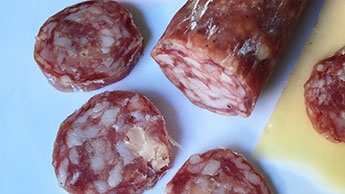
Saucisson au Camembert - French Salami with Camembert Cheese. French dry liver sausage (Saucisse seche de Foie) is another original French sausage.
….more about dry/fermented sausages
French Sausage Recipes
There are hundreds of great French sausage recipes and it would be impractical to list all of them on one page, but the most popular ones are listed below:
- Blanc de Liège - cooked
- Boudin Blanc - cooked
- Boudin Blanc-Traditonelle - cooked
- Boudin Blanc de Paris - cooked
- Boudin Blanc de Rethel - cooked
- Boudin Blanc de Toulouse - cooked
- Boudin Noir–Traditional - blood
- Boudin Noir Aux Noix - blood
- Boudin Noir á la Créme - blood
- Boudin Noir á la Flamande - blood
- Merquez - fresh
- Saucisse aux Choix - fresh
- Saucisse de Chox - fresh
- Saucisse de Choux-Cooked - cooked
- Saucisse de Foie-Traditionelle - liver
- Saucisse de Lieu Jaune au Chou - fish
- Saucisse de Montbéliard - cooked
- Saucisse de Morteau/Jésus de Morteau - fresh
- Saucisse de Pommes de Terre - cooked
- Saucisse de Strasbourg - cooked
- Saucisse de Toulouse - fresh
- Saucisse de Veau au Citron - fresh
- Saucisse Viennoise - cooked
- Saucisson de Lacaune/Saucisse de Lacaune - fermented
- Saucisson de L’Ardéche - fermented
- Saucisson d’Alsace - fermented
- Saucisson d’Ardenne - fermented
- Saucisson sec d’Auvergne/Saucisse sèche d’Auvergne - fermented
- Saucisson sec au Beaufort - fermented
- Saucisse de Montbéliard PGI (21.06.2013)
- Saucisse de Morteau/Jésus de Morteau PGI (21.08.2010)
- Saucisson d’Ardenne/Collier d’Ardenne/Pipe d’Ardenne PGI (27.10.2017) Belgian sausage
- Saucisson de l’Ardèche PGI (23.07.2011)
- Saucisson de Lacaune/Saucisse de Lacaune PGI (26.11.2015)
- Saucisson sec d’Auvergne/Saucisse sèche d’Auvergne PGI (20.09.2016)

